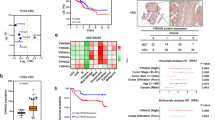Abstract
Cyclic AMP response element-binding protein (CREB) family can regulate biological functions of various types of cells and has relation with esophageal cancer cell migration and invasion. Cyclic AMP response element modulator-1 (CREM-1) is one member of the family with limited acquaintance. This study was conducted to investigate the effect of CREM-1 on migration and invasion in human esophageal squamous cell carcinoma (ESCC). The expression of CREM-1 protein in ESCC tissues with or without lymph nodes metastasis was determined by western blot. Immunohistochemical analysis of CREM-1 expression were carried out in paraffin-embedded sections of ESCC and correlated with clinical features. The roles of CREM-1 in migration and invasion were studied in TE1 cells through knocking CREM-1 down with siRNA or overexpression of CREM-1 in ECA109 cells. The regulations of CREM-1 on invasion and migration were determined by transwell and wounding healing assay. The effect of CREM-1 on chemotherapy drug was analyzed by Cell counting kit-8 assay. We found that the expression of CREM-1 was significantly downregulated in ESCC tissues with lymph nodes metastasis compared with the tissues without lymph nodes metastasis and was correlated with the clinical features of pathological grade, tumor stage and lymph node metastasis. Moreover, knocking CREM-1 down with siRNA increased cell migration and invasion in human ESCC cell lines TE1 while upregulation of CREM-1 inhibited the motility. Our data suggested that CREM-1 might play an important role in the regulation of tumor metastasis and invasion and serve as a tumor suppressor in human ESCC. We proposed that CREM-1 might be used as a potential therapeutic agent for human ESCC.






Similar content being viewed by others
References
Hu WM, Li L, Jing BQ, et al. Effect of S1P5 on proliferation and migration of human esophageal cancer cells. World J Gastroenterol. 2010;16:1859–66.
Enzinger PC, Mayer RJ. Esophageal cancer. N Engl J Med. 2003;349:2241–52.
Wang X, Tian X, Liu F, et al. Detection of HPV DNA in esophageal cancer specimens from different regions and ethnic groups: a descriptive study. BMC Cancer. 2010;10:19.
Gu Y, Lin S, Li JL, et al. Altered LKB1/CREB-regulated transcription co-activator (CRTC) signaling axis promotes esophageal cancer cell migration and invasion. Oncogene. 2012;31:469–79.
Katoh Y, Takemori H, Lin XZ, et al. Silencing the constitutive active transcription factor CREB by the LKB1-SIK signaling cascade. FEBS J. 2006;273:2730–48.
Persengiev SP, Green MR. The role of ATF/CREB family members in cell growth, survival and apoptosis. Apoptosis. 2003;8:225–8.
Herdegen T, Leah JD. Inducible and constitutive transcription factors in the mammalian nervous system: control of gene expression by Jun, Fos and Krox, and CREB/ATF proteins. Brain Res Brain Res Rev. 1998;28:370–490.
Wilson BE, Mochon E, Boxer LM. Induction of bcl-2 expression by phosphorylated CREB proteins during B-cell activation and rescue from apoptosis. Mol Cell Biol. 1996;16:5546–56.
Wu X, Jin W, Liu X, et al. Cyclic AMP response element modulator-1 (CREM-1) involves in neuronal apoptosis after traumatic brain injury. J Mol Neurosci. 2012;47:357–67.
Union Internationale Contre le Cancer (UICC), the American Joint Committee on Cancer (AJCC). Workshop on Diagnosis and Prognosis of Renal Cell Carcinoma. Rochester, Minnesota. Cancer. 1997;80:973–1000.
Yu C, Chen K, Zheng H, et al. Overexpression of astrocyte elevated gene-1 (AEG-1) is associated with esophageal squamous cell carcinoma (ESCC) progression and pathogenesis. Carcinogenesis. 2009;30:894–901.
Shi GZ, Yuan Y, Jiang GJ, et al. PRAF3 induces apoptosis and inhibits migration and invasion in human esophageal squamous cell carcinoma. BMC Cancer. 2012;12:97.
Lin CS, Lee HT, Lee SY, et al. High mitochondrial DNA copy number and bioenergetic function are associated with tumor invasion of esophageal squamous cell carcinoma cell lines. Int J Mol Sci. 2012;13:11228–46.
Eccles SA, Welch DR. Metastasis: recent discoveries and novel treatment strategies. Lancet. 2007;369:1742–57.
Chuangui C, Peng T, Zhentao Y. The expression of high mobility group box 1 is associated with lymph node metastasis and poor prognosis in esophageal squamous cell carcinoma. Pathol Oncol Res. 2012;18:1021–7.
Hanahan D, Weinberg RA. The hallmarks of cancer. Cell. 2000;100:57–70.
Hanahan D, Weinberg RA. Hallmarks of cancer: the next generation. Cell. 2011;144:646–74.
Allagnat F, Martin D, Condorelli DF, Waeber G, Haefliger JA. Glucose represses connexin36 in insulin-secreting cells. J Cell Sci. 2005;118:5335–44.
Guo Z, Du X, Iacovitti L. Regulation of tyrosine hydroxylase gene expression during transdifferentiation of striatal neurons: changes in transcription factors binding the AP-1 site. J Neurosci. 1998;18:8163–74.
He Z, Jiang J, Kokkinaki M, Golestaneh N, Hofmann MC, Dym M. Gdnf upregulates c-Fos transcription via the Ras/Erk1/2 pathway to promote mouse spermatogonial stem cell proliferation. Stem Cells. 2008;26:266–78.
Sawka-Verhelle D, Escoubet-Lozach L, Fong AL, et al. PE-1/METS, an antiproliferative Ets repressor factor, is induced by CREB-1/CREM-1 during macrophage differentiation. J Biol Chem. 2004;279:17772–84.
Salnikov AV, Liu L, Platen M, et al. Hypoxia induces EMT in low and highly aggressive pancreatic tumor cells but only cells with cancer stem cell characteristics acquire pronounced migratory potential. PLoS One. 2012;7:e46391.
Acknowledgments
This work was supported by the National Natural Science Foundation of China (No. 81201858) and Natural Scientific Foundation of Jiangsu Province Grant (No. BK2012231); a project funded by the Priority Academic Program Development of Jiangsu Higher Education Institutions (PAPD).
Conflicts of interest
None
Author information
Authors and Affiliations
Corresponding authors
Additional information
Yuchan Wang and Shuhui Zhou contributed equally to this work.
Rights and permissions
About this article
Cite this article
Wang, Y., Zhou, S., Yang, X. et al. Low expression of cyclic amp response element modulator-1 can increase the migration and invasion of esophageal squamous cell carcinoma. Tumor Biol. 34, 3649–3657 (2013). https://doi.org/10.1007/s13277-013-0946-1
Received:
Accepted:
Published:
Issue Date:
DOI: https://doi.org/10.1007/s13277-013-0946-1




